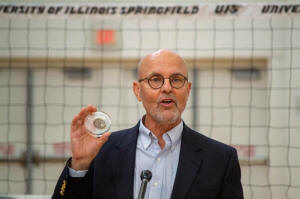Lawmakers celebrate Illinois’ role in distribution of penicillin
 Send a link to a friend
Send a link to a friend
[August 18, 2021]
By JERRY NOWICKI
Capitol News Illinois
jnowicki@capitolnewsillinois.com
 SPRINGFIELD – Lawmakers gathered Tuesday at
the University of Illinois Springfield to designate a new state microbe
and add agriculture sciences to the list of courses that fulfill
admissions requirements at state universities. SPRINGFIELD – Lawmakers gathered Tuesday at
the University of Illinois Springfield to designate a new state microbe
and add agriculture sciences to the list of courses that fulfill
admissions requirements at state universities.
Penicillium rubens NRRL 1951, which yields the antibiotic penicillin,
was designated as the official state microbe in House Bill 1879, which
Gov. JB Pritzker signed Tuesday.
While the first mold spore that produces penicillin was discovered in
Europe in 1928, the National Center for Agriculture Utilization in
Peoria, known as the Ag Lab, was the site of the penicillium rubens
discovery in the 1940s which allowed for speedier production of the
antibiotic used to treat several infections.
Peoria Democrat Sen. Dave Koehler, who sponsored the bill in the Senate,
noted penicillin’s contribution to halting bacterial infections such as
gangrene in soldiers wounded in World War II.

“There was no way to treat it,” Koehler said while holding up a specimen
of the mold discovered in Peoria. “Penicillin stopped that.”
“Not only did the mass production of penicillin in Peoria change the
world by helping us win World War II and saving countless lives across
the globe, but it also provided an important recipe that I think we
should follow here in Illinois today,” House sponsor Rep. Ryan Spain,
R-Peoria, said at the news conference. “Currently, as many investments
in our country for research and development have migrated to the East
and West Coast, this recognition today in this bill signing is a
reminder that there is a place for discovery and implementation here in
Illinois.”
Spain announced stakeholders from his hometown in Peoria are launching a
“comprehensive effort to return bio manufacturing and pharmaceutical
mass production to central Illinois,” known as Peoria Bio-Made.
“We are collaborating with leading biotech entrepreneurs in San Diego
and Boston to bring discoveries from the coast back to Peoria for
last-mile testing and full scale production,” he said.
Pritzker also took time to recognize Mary Hunt, known as “Moldy Mary,”
who was a researcher at the lab who collected and tested mold samples,
including the moldy cantaloupe that led to the discovery of the more
easily cultured penicillium strain.
[to top of second column]
|

Sen. Dave Koehler, D-Peoria, speaks at a news
conference Tuesday in Springfield, holding a specimen of penicillium
rubens, which was discovered in Peoria in the 1940s and named the
official state microbe in Illinois this week. It's a specimen used
to widely distribute the antibiotic penicillin. (Capitol News
Illinois photo by Jerry Nowicki)

A bipartisan group of lawmakers also celebrated the
governor’s signature on House Bill 3218 and Senate Bill 1624, two
measures that add “agriculture education” to the list of acceptable
electives that qualify a student for admission to state
universities, and “agricultural sciences” to the list of acceptable
science courses for admission.
“These young people who are taking agricultural science, it allows
them to meet the science requirements in high school, so as they
move through college, they've got that background,” Sen. Elgie Sims,
D-Chicago, who sponsored the bill, said at the news conference. “So
it allows them to expand their horizons; again, it opens up all
those pathways to success.”
Earlier Tuesday, Pritzker kicked off Agriculture Day at the Illinois
State Fair in Springfield.
“This expansion of agricultural education options was made possible
by students, teachers, FFA clubs and lawmakers coming together to
ensure that high school students in Illinois can access the tools
they need to continue our proud Illinois agriculture tradition,” he
said.

The three bills signed Tuesday take effect in January.
Capitol News Illinois is a nonprofit, nonpartisan
news service covering state government and distributed to more than
400 newspapers statewide. It is funded primarily by the Illinois
Press Foundation and the Robert R. McCormick Foundation. |